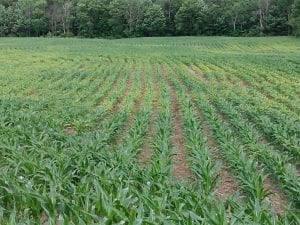So far, the 2020 growing season has been super dry. Planter-delivered N has likely been used efficiently or is still present and available to the crop. The pre-sidedress nitrate test (PSNT) is a good tool for some guidance in 2nd year corn and beyond, or in fields where manure N sufficiency is in question. In other words, in 1st year corn and in fields with adequate manure N, the PSNT is not needed and not recommended. The PSNT is a simple nitrate test on 12” depth, dried soil samples. The normal guidelines are as follows:
- If the nitrate content is 25ppm or greater, no additional sidedress N is recommended.
- For nitrate content of 21ppm or less, fertilize according to the Cornell Field Crops Guide (sidedress N = Total N recommended – Planter applied N, with credits applied for manure, sod, previous crop, etc.).

Stressed corn in Lewis County. Photo by Mike Hunter, June 2020. - For fields where nitrate is 21-24ppm, consider applying just 25-50 lbs N.
This year, PSNT results have been high overall, indicating less sidedress fertilizer N is needed than typical. This is likely a result of late-warming soils which delayed plant uptake and delayed SOM decomposition until our recent stretch of hot weather, together with very little rain to potentially leach any planter-applied N away. Take a few PSNT samples as described here, and view your results as a group combined with field histories of sod, legume and manure applications to guide decisions. PSNTs will continue to be higher than normal until we get some rain to stimulate plant growth and uptake. Consider corn stage with the PSNT results – a high PSNT in 12” corn would indicate even more soil N is available than the same result in 5” corn. Reduce sidedress N applications where appropriate and consider using an untreated check strip to evaluate N management at the end of the season.
Plan N fertilizer materials carefully to minimize volatilization loss. Our extremely warm and dry weather across NNY has raised some questions about increased potential for ammonia-N volatilization loss (the loss of N to the air as ammonia gas) during sidedressing this year. Any urea-containing fertilizer applied to the soil surface during warm, dry, windy conditions will be at risk for significant volatilization losses. Soil moisture is needed to first dissolve the urea and then to convert resulting ammonia to NH4+ which remains in the soil. Risk is maximized when there is just enough moisture to dissolve the urea but not enough to carry the reactions all the way to NH4+. Volatilization loss occurs quickly, with most occurring within 2 days following application. Urea (46-0-0) and UAN (urea ammonium nitrate, liquid, 28-0-0 or 32-0-0) are common urea-based N choices for sidedressing corn. Both contain urea and have the potential for ammonia volatilization loss and this loss can be 0 or 70+% depending on conditions, management and timing. UAN contains part of its N in the form of nitrate, which is not at risk of volatilization, so its upper limit of loss is lower than for urea. Soil pH, soil temperature, soil moisture, placement of the urea, wind speed, soil chemical and biological properties, and timing and amount of rain or irrigation all influence the proportion of N lost through volatilization. Losses to the atmosphere can be reduced by pairing the N application with tillage within 1-2 days of precipitation, by sidedressing just prior to a forecast rain of at least 0.5”, using a urease inhibitor to protect N to allow for up to 10-14 days for that 0.5” rain event to occur. A reduced rate of urease inhibitor is needed for UAN, as it contains less urea than 46-0-0.
Thank you to Dr. Quirine Ketterings (Cornell University), Joe Lawrence (PRO-DAIRY), and Mike Hunter for their contribution to this update.
